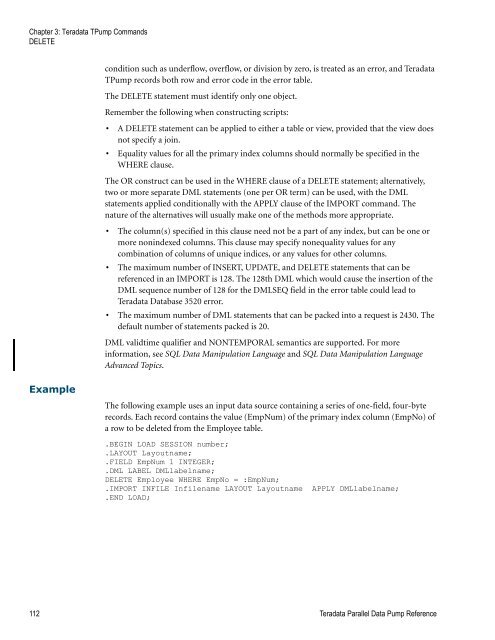Teradata Parallel Data Pump
Teradata Parallel Data Pump Reference - Teradata Developer ...
Teradata Parallel Data Pump Reference - Teradata Developer ...
- No tags were found...
You also want an ePaper? Increase the reach of your titles
YUMPU automatically turns print PDFs into web optimized ePapers that Google loves.
Chapter 3: <strong>Teradata</strong> T<strong>Pump</strong> Commands<br />
DELETE<br />
condition such as underflow, overflow, or division by zero, is treated as an error, and <strong>Teradata</strong><br />
T<strong>Pump</strong> records both row and error code in the error table.<br />
The DELETE statement must identify only one object.<br />
Remember the following when constructing scripts:<br />
• A DELETE statement can be applied to either a table or view, provided that the view does<br />
not specify a join.<br />
• Equality values for all the primary index columns should normally be specified in the<br />
WHERE clause.<br />
The OR construct can be used in the WHERE clause of a DELETE statement; alternatively,<br />
two or more separate DML statements (one per OR term) can be used, with the DML<br />
statements applied conditionally with the APPLY clause of the IMPORT command. The<br />
nature of the alternatives will usually make one of the methods more appropriate.<br />
• The column(s) specified in this clause need not be a part of any index, but can be one or<br />
more nonindexed columns. This clause may specify nonequality values for any<br />
combination of columns of unique indices, or any values for other columns.<br />
• The maximum number of INSERT, UPDATE, and DELETE statements that can be<br />
referenced in an IMPORT is 128. The 128th DML which would cause the insertion of the<br />
DML sequence number of 128 for the DMLSEQ field in the error table could lead to<br />
<strong>Teradata</strong> <strong>Data</strong>base 3520 error.<br />
• The maximum number of DML statements that can be packed into a request is 2430. The<br />
default number of statements packed is 20.<br />
DML validtime qualifier and NONTEMPORAL semantics are supported. For more<br />
information, see SQL <strong>Data</strong> Manipulation Language and SQL <strong>Data</strong> Manipulation Language<br />
Advanced Topics.<br />
Example<br />
The following example uses an input data source containing a series of one-field, four-byte<br />
records. Each record contains the value (EmpNum) of the primary index column (EmpNo) of<br />
a row to be deleted from the Employee table.<br />
.BEGIN LOAD SESSION number;<br />
.LAYOUT Layoutname;<br />
.FIELD EmpNum 1 INTEGER;<br />
.DML LABEL DMLlabelname;<br />
DELETE Employee WHERE EmpNo = :EmpNum;<br />
.IMPORT INFILE Infilename LAYOUT Layoutname APPLY DMLlabelname;<br />
.END LOAD;<br />
112 <strong>Teradata</strong> <strong>Parallel</strong> <strong>Data</strong> <strong>Pump</strong> Reference









